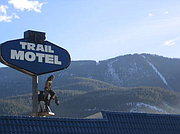Roadside Vernacular: Part 1
Whizz, bang, boom, ala I-90.
Pedal to the metal virtual reality.
All weaponized AI plugged in X-bot.
Text Sirius Siri on the joystick.
OK so crank it down.
STOP already!
Time to open your eyes and look around at the Silver Valley roadside whimsy AKA roadside vernacular. Yeah we’re talking architectural icons that exemplify bona fide architectural theory.
Hayman’s roof top hot rod; the Miner’s Hat Coney Dogs; Flying soccer at the Center of the Universe; Native American on horseback at the end of the trail- Bona fide.
In fact, in response to Modernist patriarch Mies van der Rohe’s maxim “less is more.”
Post-modernist raconteur Robert Venturi retorts, “less is bore.”
“People should care,” said Professor Randall Teal, program head of architecture at the University of Idaho.
“The roadside vernacular provides a uniquely American experience, it’s playfulness and oddity simultaneously capture (and contribute to) the spirit of the open road and the mythology of the ‘road trip.’ Roadside vernacular is a good way of grouping together the architecture and signage of the Silver Valley. Under Venturi’s theory, they can be grouped together as roadside architecture. Many examples in the Silver Valley fall somewhere in between the ‘Duck’ and the ‘Decorated Shed. With the ‘Duck,’ the building is what it is by it’s form (three dimensional embodiment) whereas the ‘Decorated Shed’ is a furnished facade that announces itself through signage announcement billboards.”
So without further ado, sit back, relax, and satiate your roadside curio curiosity!
Hayman’s Auto
Body & Towing
How in the name of American Graffiti did that hot rod land plumb on the metal roof of Hayman’s Auto Body and Towing?
Seems this neon green roadster can dial in airborne.
And as far as the blonde at the wheel, look out!
She will eat your nitrous for breakfast.
“We call her, ‘Alice,’” said Rich Hayman, auto body artist and owner of the Wallace business. “The blonde keeps a watch on the place.”
Rich Hayman’s roof-top, 1929 Model A exemplifies roadside vernacular as a head-turning road sign that communicates a message.
Using his auto body talents, Hayman created the sign about 17 years ago after he got half a chassis of a Model A.
He used sheet metal, paint and other materials to create his whimsical sign.
The car has been painted pink, harlequin, and now green.
It features mag wheels and head, brake and interior lights; and of course Alice the mannequin.
The car is visible at night.
The basic thing it lacks is an engine.
The project took about two months and when finished was fork-lifted onto the shop’s roof.
Later, when the shop was expanded, it was moved to the new rooftop.
The car is an icon throughout the Silver Valley, Northern Idaho, and Eastern Washington.
The Brooks Hotel
Chef Virgil
Imagine a cross between a Parisian Pillsbury Dough Boy and Idahoan Jacques Pepin.
What you would have would be Chef Virgil, a top rated, Michelin Silver Valley winner in charge of the blackboard daily specials at The Brooks Hotel.
Oh là là ! What shall Panhandle gourmands savour today?
Perhaps huckleberry haute cuisine or Virgil’s Five Star Rocky Mountain Oysters?
Chef Virgil may be a fiberglass statue but he exudes an infectious joie de vivre in worthy remembrance of a Brook’s favorite, Virgil Miller.
“Virgil was always smiling, singing or being kind of jolly,” said Julie Hinsz, long time Brooks Hotel waitress.
Virgil worked there as a restaurant manager and a cook, she said.
“He (the statue) used to be inside the building more. When he was in the building, a lot of people would stand next to Virgil to get their pictures taken.”
Sometime around the mid-1990s, Virgil came to work at The Brooks Hotel, a historic building completed in 1905 originally founded as a hospital.
Prior, Virgil worked at the Third Generation Restaurant in Catalba started by his parents James and Dorothy in 1983.
The restaurant closed because of the flood in 1996.
Sometime after Virgil came to work, the chef statue was purchased because it resembled Virgil and the rest is, wel,l Wallace cuisine.
Time has passed.
Brook’s people have died.
But the smiling fiberglass chef remains.
“He is darling,” said Jo Lansdale, Brooks Hotel general manager.
Trail Motel Sculpture titled “the End of the Trail.”
Happy Trails to the Trail Motel for preserving a Jerry Beebe original on top of the historic building.
Titled “the End of the Trail,” the life-size replica of a weary Native American on horseback bespeaks vintage roadside vernacular as well as collectible sculpture.
The Silver Valley chainsaw artist carved it from a 350-year-old cedar found at Settlers Grove in North Idaho.
Beebe whose son is also a chainsaw artist, reportedly created the statue in the 1970s. The motel, built reportedly sometime in the 1950s, is located in Kellogg.
The building, signage, and location are historic and noteworthy.
“It’s a really nice quaint motel,” said Melinda Hulstrum, co-manager of the motel.
“This is a historic site.”
“At the Trail Motel, we hope the weary traveler finds a restful trail’s end,” she said. “The weary traveler on horseback represents the end of the trail, and the end of the trail for the Native American.”
The managers’ preservation efforts for the building and the signage/sculpture are important in recognizing the historic artifact which functions as roadside advertising and as artistic,cultural and historical comment.
“About two years ago, I got up there on the roof and repainted the Native American. It was so rough you couldn’t tell any of the colors,” said Don Byrd, co-manager.
“It took a week. I used seven different colors. It looks great.”
Check out the Wednesday, June 21 edition of the Shoshone News-Press for Part 2.





